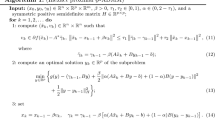Abstract
Recently, the alternating direction method of multipliers has attracted great attention. For a class of variational inequalities (VIs), this method is efficient, when the subproblems can be solved exactly. However, the subproblems could be too difficult or impossible to be solved exactly in many practical applications. In this paper, we propose an inexact method for structured VIs based on the projection and contraction method. Instead of solving the subproblems exactly, we use the simple projection to get a predictor and correct it to approximate the subproblems’ real solutions. The convergence of the proposed method is proved under mild assumptions and its efficiency is also verified by some numerical experiments.


Similar content being viewed by others
References
Signorini, A.: Questioni di elasticità non linearizzata e semilinearizzata. Rend. Mat. Appl. 18, 95–139 (1959)
Kinderlehrer, D., Stampacchia, G.: An Introduction to Variational Inequalities and Their Applications. Siam, Philadelphia (2000)
Facchinei, F., Pang, J.S.: Finite-Dimensional Variational Inequalities and Complementarity Problem. Springer, New York (2003)
Glowinski, R., Lions, J.L., Tremolieres, R.: Numerical Analysis of Variational Inequalities. Elsevier, Engelska (2011)
Bertsekas, D.P., Gafni, E.M.: Projection method for variational inequalities with applications to the traffic assignment problem. Math. Program. Study 17, 139–159 (1987)
Fukushima, M.: Application of the alternating directions method of multipliers to separable convex programming problems. Comput. Optim. Appl. 2, 93–111 (1992)
He, B.S.: The solution and application of a class of generalized linear variational inequalities. Sci. China 38, 939–945 (1995). (in Chinese)
Nagurney, A.: Network Economics, A Variational Inequality Approach. Kluwer Academics Publishers, Dordrect (1993)
Glowinski, R., Marrocco, A.: Sur l’approximation par éléments finis d’ordre 1 et la résolution par pénalisation-dualité d’une classe de problèmes de Dirichlet nonlinéaires. C. R. Acad. Sci. 278A, 1649–1652 (1974)
Glowinski, R., Marrocco, A.: On the solution of a class of nonlinear Dirichlet problems by a penalty–duality method and finite elements of order one. In Optimization Techniques, IFIP Technical Conference: Marchuk G.I. (eds.): Lecture Notes in Computer Sciences, 27, 327–333. Springer, Berlin (1974).
Chan, T.F., Glowinski, R.: Finite Element Approximation and Iterative Solution of a Class of Mildly Non-linear Elliptic Equations. Computer Science Department, Stanford University, Stanford (1978)
Gabay, D., Mercier, B.: A dual algorithm for the solution of nonlinear variational problems via finite-element approximations. Comput. Math. Appl. 2, 17–40 (1976)
Eckstein, J., Bertsekas, D.P.: On the Douglas–Rachford splitting method and the proximal point algorithm for maximal monotone operators. Math. Program. 55, 293–318 (1992)
Eckstein, J., Fukushima, M.: Some reformulation and applications of the alternating direction method of multipliers. In: Hager, W.W. (ed.) Large Scale Optimization: State of the Art, pp. 115–134. Kluwer Academic Publishers, Dordrecht (1994)
Gabay, D.: Applications of the method of multipliers to variational inequalities. In: Fortin, M., Glowinski, R. (eds.) Augmented Lagrange Methods: Applications to the Solution of Boundary-Valued Problems, pp. 299–331. North-Holland, Amsterdam (1983)
Glowinski, R.: Numerical Methods for Nonlinear Variational Problems. Springer, New York (1984)
Glowinski, R., Le Tallec, P.: Augmented Lagrangian and Operator-Splitting Methods in Nonlinear Mechanics. SIAM Studies in Applied Mathematics. SIAM, Philadelphia (1989)
Chen, G., Teboulle, M.: A proximal-based decomposition mathod for convex minimization problems. Math. Program. 64, 81–101 (1994)
Han, D.R.: A proximal decomposition algorithm for variational inequality problems. J. Comput. Appl. Math. 161, 231–244 (2003)
Han, D.R., Lo, H.K.: Solving variational inequality problems with linear constraints by a proximal decomposition algorithm. J. Global. Optim. 28, 97–113 (2004)
Han, D.R.: A hybrid entropic proximal decomposition method with self-adaptive strategy for solving variational inequality problems. Comput. Math. Appl. 42, 195–212 (2009)
He, B.S., Liao, L.Z., Han, D.R., Yang, H.: A new inexact alternating direction method for monotone variational inequalities. Math. Program. 92, 103–118 (2002)
He, B.S.: Parallel splitting augmented Lagrangian methods for monotone structured varia-tional inequalities. Comput. Optim. Appl. 42, 195–212 (2009)
Zhang, M., Han, D.R., He, H.J., et al.: A new alternating direction method for solving separable variational inequality problems. Sci. Sin. Math. 42, 133–149 (2012). (in Chinese)
Yang, Q.Z.: The relaxed CQ algorithm solving the split feasibility problem. Inverse Probl. 20, 1261–1266 (2004)
He, B.S., Xu, M.H.: A general framework of contraction methods for monotone variational inequalities. Pacific J. Optim. 4, 195–212 (2008)
Tao, M., Yuan, X.M.: An inexact parallel splitting augmented Lagrangian method for monotone variational inequalities with separable structures. Comput. Optim. Appl. 52, 439–461 (2012)
He, B.S., Liao, L.Z., Qian, M.J.: Alternating projection based prediction-correction methods for structured variational inequalities. J. Comput. Math. 24, 693–710 (2006)
He, B.S., Liao, L.Z., Yuan, X.M.: A LQP based interior prediction–correction method for nonlinear complementarity problems. J. Comput. Math. 24, 33–44 (2006)
Nagurney, A., Zhang, D.: Projected Dynamical Systems and Variational Inequalities with Applications. Kluwer Academic, Boston (1996)
Acknowledgments
The authors are very grateful to the editor and the anonymous referees for their valuable suggestions and constructive comments, which have considerably improved the presentation of the paper. Qingzhi Yang’s work is supported by the National Natural Science Foundation of China (Grant No. 11271206), Doctoral fund of Chinese Ministry of Education (Grant No. 20120031110024).
Author information
Authors and Affiliations
Corresponding author
Rights and permissions
About this article
Cite this article
Chen, Z., Wan, L. & Yang, Q. An Inexact Alternating Direction Method for Structured Variational Inequalities. J Optim Theory Appl 163, 439–459 (2014). https://doi.org/10.1007/s10957-014-0522-x
Received:
Accepted:
Published:
Issue Date:
DOI: https://doi.org/10.1007/s10957-014-0522-x



